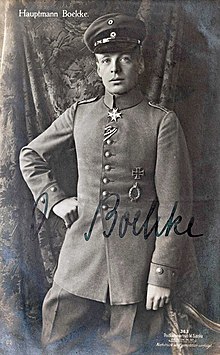Oswald Boelcke | |
|---|---|
 Oswald Boelcke wearing his Pour le Mérite | |
| Born | 19 May 1891 Giebichenstein, Province of Saxony, Prussia; near Halle (Saale) |
| Died | 28 October 1916 (aged 25) near Bapaume, France |
| Allegiance | German Empire |
| Service | Telegraphen-Bataillon Nr. 3 (Telegraph Battalion No. 3); Luftstreitkräfte (Air Force) |
| Years of service | 1911–1916 |
| Rank | Hauptmann (Captain) |
| Unit | Feldflieger Abteilung 13 (Field Flyer Detachment 13) |
| Commands | Jagdstaffel 2 (Fighter Squadron 2) |
| Awards | Pour le Mérite, Royal House Order of Hohenzollern, Knight's Cross with Swords, Iron Cross, First and Second Class, Lifesaving Medal, Plus eight lesser decorations |
Oswald Boelcke PlM (German: [ˈbœlkə]; 19 May 1891 – 28 October 1916) was a World War I German professional soldier and pioneering flying ace credited with 40 aerial victories. Boelcke is honored as the father of the German fighter air force, and of air combat as a whole. He was a highly influential mentor, patrol leader, and tactician in the first years of air combat, 1915 and 1916.
Boelcke fulfilled his childhood dream of a military career by joining the Imperial German Army on 15 March 1911. He pursued an early interest in aviation, learning to fly as World War I began. After duty as an aerial observer during 1914, he became one of the original fighter pilots during mid-1915. Flying the first true fighters, Boelcke, Max Immelmann, and several other early aces began shooting down enemy airplanes. Boelcke and Immelmann were the first German fighter pilots awarded Prussia's highest honor, the Pour le Mérite. The German high command reassigned Boelcke after his 19th victory. During his forced grounding on staff duty, he helped transform Die Fliegertruppe (Flying Troop) air arm into the Luftstreitkräfte (Air Force). His innovative turn of mind codified his combat experiences into the first manual of fighter tactics distributed to an air force, the Dicta Boelcke. The Dicta promulgated axioms for individual pilot success, as well as a requirement for teamwork directed by a formation's leader. Modern aerial combat tactics manuals stem from the Dicta.
After an enforced holiday leave spent on a military inspection tour of Ottoman facilities, Boelcke was picked to lead one of Germany's first fighter squadrons, Jagdstaffel 2 (Fighter Squadron 2). Its pilots were hand-picked by Boelcke and indoctrinated in his Dicta through extensive training. During September and October 1916, Boelcke scored 21 more victories while commanding Jagdstaffel 2, maintaining his position as the world's highest-scoring ace. He was killed in a mid-air collision with his best friend, Erwin Böhme, on 28 October 1916. By the end of the war, Jagdstaffel 2 (renamed Jasta Boelcke) had 25 aces in its ranks; many of them were selected to lead other squadrons and four of its members became generals during World War II. Boelcke's influence extends to the present, with extensive tributes to him at the German Air Force's Nörvenich Air Base and throughout Germany.